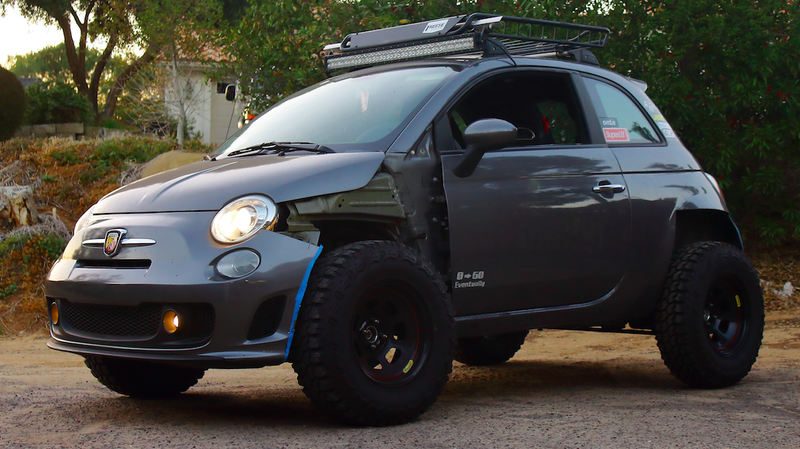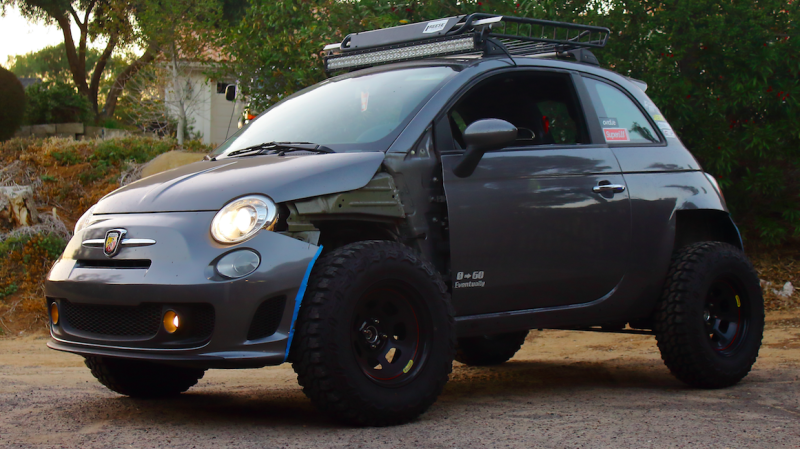
Around the country, people have been lifting their cars and installing big tires as part of the blossoming “safari” trend, and San Diego native Zachary Parfrey wanted in on it. So he decided to lift his daily driver, a 2012Fiat 500 Abarth, and to install mud-terrain tires. The result was a machine so awful, it twice caused Parfrey to lose control and nearly crash. Eventually, he had no choice but to undo his modifications just to make the car drivable.
This is a story about a man with a dream to turn his little Italian sports car into a desert-crushing off-roader. But that man didn’t have the experience or tools to make that dream come true the proper way, and it nearly cost him dearly.
It all began during the Fourth of July weekend this year, when the San Diego native got up early and drove his only car, a Fiat 500 Abarth, two hours out to the desert to have some fun. Unfortunately, he tried driving on sand, and quickly fell into trouble on the roughly 110 degree day.
Getting Stuck in the Desert Gave Him the Harebrained Idea
Advertisement
Taking the 500 Abarth on sand was a bad idea. “I felt my car start to slow down and the steering was uncontrollable, and my car just buried itself deep under the sand,” he told me. It didn’t take long for him to realize how bad of a situation he was in, and not just because he was stuck in a scalding hot desert without water. “I didn’t tell anybody I was going to the desert,” he told me over the phone.
After wasting an hour trying to dig the car out, and frequently jumping back into his car to take refuge in that sweet, sweet air conditioning, Zachary walked a quarter mile to a road, and after allegedly being told by the California Highway Patrol that they’re there to help with issues that occur on the road, not off, Parfrey hung up out of frustration.
Advertisement
He eventually spotted a broken-down Ford F-150 that kept sputtering because of a fuel delivery issue. The driver said the state of his truck meant he couldn’t help, and a van passing by also refused, driving by despite the stranded Parfrey waving his hands. Eventually a Toyota Tacoma driver traveling with his wife and kids stopped and let him into the truck.
They all drove to the 500, hooked a strap between the Toyota and the 500, and then Parfrey jumped into his stuck little hot hatch. The Taco-driving gentleman gave him a tug, but unfortunately, that tug pulled the side of Parfrey’s 500 into a bush, causing a bit of damage.
Parfrey was unfazed, but before parting ways with the Taco driver, he expressed his appreciation and admitted his fault, saying the Fiat 500 never should have been out there in the dirt, to which the Taco driver responded, simply: “Why not?” Then the truck drove away.
Advertisement
These two words—along with some inspiration from someone who made a custom tube-frame 500 and all the prerunner Subarus out there—gave Parfrey a wacky idea.
Building the Fiat 500 Abarth Prerunner
Advertisement
Four weeks after this experience in the desert, Parfrey—who had originally wanted to do a track car build on his “mean, squirrely little car”—picked up a set of Bassett steel wheels and 29-inch mud terrain tires. “I’m gonna make these fit on my car whatever it takes,” he resolved. So in early August, the build began.
Living in a San Diego apartment that didn’t allow wrenching, Parfrey had to drive an hour to his mom’s place just to work on his build. Over the next few months, he drove to and from her house, fabricating parts, cutting, and wrenching. He usually started his more difficult wrenching at the beginning of each weekend so that if something went wrong, he could stay the night and have it fixed in time for work on Monday.
Eventually, he’d done it—the Fiat 500 Abarth was lifted, and the tires fit. But the job was sketchy.
Advertisement
Deciding that putting a spacer at the top strut towers wasn’t feasible, Parfrey used two 1/16-inch steel spacer plates (shown above and below) for each wheel. If you look at the image above, you’ll see what he did. The bottom of the strut is normally supposed to bolt into the knuckle in two spots. Parfrey unfastened the two bolts, then moved the lower strut bracket holes to align with the upper knuckle hole. The two spacer plates on either side tied the lower knuckle hole to this attachment, and also with the upper strut bracket holes.
Notice the sleeve between the two upper strut bracket holes; that’s apparently there so that when Parfrey tightened the bolt, the two sides of the bracket wouldn’t try to squeeze together.
Advertisement
It’s very basic lift setup that doesn’t consider effects on CV joint angles, camber, or on other factors that affect handling (especially torque steer)—areas that need to be analyzed well before fabricating and installing parts.
For the rear, he bought coil springs meant for mid-1970s Ford Pintos and Ford Mustang IIs, and cut those down to length. Between those and the full-size truck off-road shocks he bought, the ride got a bit stiffer, but Parfrey thinks he got about five-inches of lift out of it—about an inch more than his spacers netted him up front.
Advertisement
Even with the four-inch lift up front and the five out back, and with one-inch adapters that pushed the wheels outboard an inch, fitting the 29-inch tires on a car designed to fit only ~24s took some serious body work.
To prevent the big mud-terrains from shredding themselves, Parfrey had to trim the front bumper cover and a bit of each strut, and also cut into the firewall. “There was very little turning radius, so I had to cut back a bunch of that so there was enough turning radius and suspension travel,” he told me.
Advertisement
Out back, he had to remove the bumper cover, cut some of the bumper, and hack both the outer and inner fender, which actually opened the inside of the car to the elements, and made driving the car significantly louder.
Advertisement
In the end, Zachary achieved his goal: he got the wheels and tires to fit. But at what cost?
The Setup Nearly Killed Him
Advertisement
“Obviously,” the ambitious wrencher told me, “the 500 wasn’t built for wheels and tires that weigh twice as much as the original. It was causing a lot of problems.”
“It was so much slower than it was originally. I couldn’t really get used to it. It felt really slow.”
But the worse problems dealt with handling. For example, torque steer, which he says the stock 500 already had a bit of thanks in part to its unequal halfshaft lengths. “That was significantly exaggerated then I put the wheels and tires on. Almost to an uncontrollable state,” he told me.
Advertisement
This, along with negative camber issues that he tried fixing with new spacer plates that had holes drilled at an angle, caused led to serious trouble on the roadway. “There were a couple of instances when the car was uncontrollable and I almost crashed,” he admitted before telling two terrifying stories.
The first was about a drive home from his mom’s house, climbing a hill that, with those giant tires, required a downshift to 4,000 RPM. “Because my car had less power, I was in third and I was accelerating up the hill,” he said. “I was going about 70 mph and I shifted into fourth gear.” In a split second, he told me, the car succumbed to both lift-off oversteer and torque steer, veering off to the right, uncontrollably. “I was probably about 6-12 inches from missing the guardrail,” Parfrey said.
Advertisement
The second near-death experience happened on his daily commute on a winding road when his CV axle, whose inner CV boot had already ripped, bound up, locked up the tire, and pulled the car into the oncoming lane. That’s when Zachary resolved: “I gotta take these [tires] off, otherwise they’re gonna kill me.”
Ditching the Lift and Tires and Putting the Car Back to Stock
Advertisement
So that’s what he did. He drove back to his apartment, and within two hours, the lift and tires were off, and the car was basically stock—well, aside from the trimmed body panels.
In his latest Instagram post, Zachary—whose username is, appropriately, broken_abarth—shows a picture of his car with the lift and tires removed, and discusses some of the lessons he learned from this whole experience:
It was a fun project while it lasted, and definitely an experience to remember. I learned a lot on this simple build, mostly that big wheels and tires on a Fiat will almost always try to kill you at every chance they get.
All in all though, I had a blast, got a lot of attention, and found out just how slow she can be.
Advertisement
“If i had more money and I had a welder and more knowledge on how to effectively destroy a car and then put it back together,” Zachary concluded with me on the phone, “this would have been a more sustainable project.”
There are a couple of takeaways, here. The positive one is is that even a failed project can be a valuable learning experience. But perhaps the more important one is that lifting a car like a Fiat 500—something that was never meant to be lifted—can be more difficult than you think, and it’s definitely not something you want to just improvise.
Advertisement
Understanding suspension geometry and how it factors into vehicle dynamics is critical, as is having a firm grasp on stresses that suspension and steering components are subject to. Simply fabbing up spacers and throwing on bigger tires might work okay on an old leaf-sprung pickup, but it’s not going to work on everything.
Vehicle suspension are complex, and while I like that Parfrey decided to go for it, and I appreciate that he eventually realized it was too dangerous to keep driving, his tale is a cautionary one for folks looking to throw a quick-and-dirty lift onto their vehicles.
If you’re going to modify your suspension, you’ve got to understand how it will change your car’s behavior. Because this kind of stuff could get you killed.
Advertisement
(Also, my recent blog “Safari All the Cars” might have been a bad take).
h/t: Dustin!















